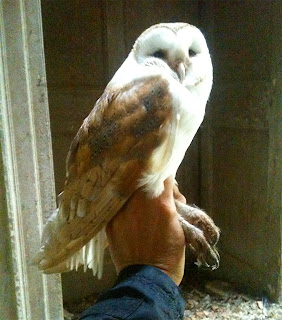While conducting an evening watch on a Barn Owl nest box site on Friday a most unusual event was witnessed by Michael O'Clery...
The scene of the action – the nest box on the chimney, the telegraph pole and the grey roof of the barn behind (Photo: M.O'Clery).
"From my position, hidden by the field edge, I could watch one of our nest boxes, on top of a chimney in Co. Kerry. As dusk fell, an adult Barn Owl flew out of its roost in an adjacent barn and landed on a telegraph pole near the nest box. One of the young Barn Owls saw the adult land and came to the entrance of the nest box and started 'snoring' loudly for food. The adult looked toward the box and then started to stare at the rough grass below its high perch.
"Judging by the intensity of the attention, I thought I might see the adult Barn Owl make a kill on some small mammal below, however another movement behind the owl caught my attention. A female Sparrowhawk flew low and fast over the roof of the barn and flew straight at the Barn Owl.
"The owl was oblivious to the approaching danger from behind, but at the very last second turned, saw the Sparrowhawk, and virtually leapt into the air to meet the Sparrowhawk, talons to talons, before flying downward, low and fast into the nearest copse of trees. The Sparrowhawk which had to stall mid-flight, then twisted to make a 180 degree turn to pursue the owl with astonishing acceleration. The initial loss of speed of the Sparrowhawk however seemed to just allow the owl time to make good its escape and the Sparrowhawk pursued the owl to the edge of the treeline before gliding up an over. It seems the owl had a very narrow escape."
Female Sparrowhawk (Photo: Ben Phalin).
Female Sparrowhawk with a freshly killed Magpie (Photo: David J. Coley).
Barn Owls have few predators, and on the continent, Goshawks are the only raptors which have been regularly documented as killing Barn Owls in the wild. However in two studies on mortality of Barn Owls in England, of nearly 300 documented deaths of Barn Owls, three were attributed to Buzzards, and one to a Sparrowhawk.
A female Sparrowhawk will regularly take relatively large prey such as Woodpigeon and Magpie. The weight of an adult Woodpigeon is about 400 grammes, whereas Barn Owls typically weigh in at about 280 to 310 grammes, so it would seem that Barn Owls might well occasionally feature on the Sparrowhawk menu.








.jpg)
.jpg)







